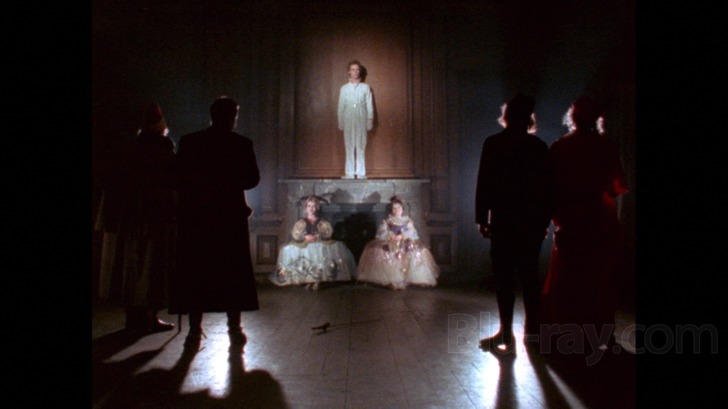The Tempest Blu-ray Movie
HomeThe Tempest Blu-ray Movie 
Derek JarmanKino Lorber | 1979 | 95 min | Not rated | Aug 07, 2012

Movie rating
7 | / 10 |
Blu-ray rating
| Users | 0.0 | |
| Reviewer | 3.0 | |
| Overall | 3.0 |
Overview
The Tempest (1979)
An experimental and anachronistic adaptation of William Shakespeare's play which casts the mad Prospero as a struggling artist desperate to transform his bleak world into something more spriritually satisfying.
Starring: Peter Bull (I), David Meyer (I), Neil Cunningham (I), Heathcote Williams, Richard WarwickDirector: Derek Jarman
| Drama | 100% |
Specifications
Video
Video codec: MPEG-4 AVC
Video resolution: 1080p
Aspect ratio: 1.33:1
Original aspect ratio: 1.37:1
Audio
English: LPCM 2.0
Subtitles
None
Discs
25GB Blu-ray Disc
Single disc (1 BD)
Playback
Region A (locked)
Review
Rating summary
| Movie | 3.5 | |
| Video | 3.0 | |
| Audio | 3.0 | |
| Extras | 2.5 | |
| Overall | 3.0 |
The Tempest Blu-ray Movie Review
Stormy weather ends in sunshine.
Reviewed by Casey Broadwater August 10, 2012By 1979, director, diarist, and gay-rights activist Derek Jarman was the U.K.'s underground filmmaker du jour, a sort of Andy Warhol meets No-Wave figure in London's art world. He had just made Jubilee, the first bonafide English punk film, in which a time-traveling Queen Elizabeth I is warped into a 1970s dystopian nightmare that makes A Clockwork Orange look like Billy Elliot. (Okay, that's a slight exaggeration.) The queen's journey through time is the work of Ariel, the impish spirit from Shakespeare's The Tempest, which Jarman would choose to adapt as his next film. Rampant with nudity and creepy production design, Jarman's version of the Bard's final tale is nothing like the tame Hallmark Hall of Fame production your English teacher might've showed you in high school. The director held little deference to fusty Shakespearean traditionalism, preferring to endow the film with his own transgressive aesthetic, anarchic and deconstructed, cut-up, haunting, and, in the over-the- top finale—which features cabaret singer Elisabeth Welch performing "Stormy Weather," surrounded by dancing gay sailors—decidedly camp. Original doesn't quite cut it, and like most of Jarman's films, it really has to be seen to be believed.

Prospero and Ariel
Though he diverges greatly elsewhere, Jarman does largely stay true to the gist of the play's plot. Actor, poet, and real-life conjuror Heathecote Williams plays the exiled magician Prospero, the erstwhile Duke of Milan, who was marooned on a distant island with his daughter, Miranda (punk goddess Toyah Willcox), after his jealous brother Antonio (Richard Warwick) usurped his title. In Jarman's version, they live in a decrepit mansion with hay-strewn floors, along with their resentful servant Caliban (Jack Birkett), the deformed son of the dead witch Sycorax. Also present—but only visible to Prospero—is Ariel (Karl Johnson), a spirit rescued from the witch and compelled to serve his new magician master.
Prospero has promised to free Ariel if he'll help lure a ship to the island carrying Antonio and his companions—co-conspirator King Alonso (Peter Bull), his innocent son Ferdinand (Peter Meyer), his scheming brother Sebastian (Neil Cunningham), and his councilor Gonzolo (Ken Campbell)—so that the rightful Duke can have his retribution and regain his position. Part of Prospero's plan is to fix up his comely daughter with Ferdinand, who washes up naked on shore—after the titular tempest—and stumbles into the mansion seeking shelter. This romance forms the spine of the narrative, with two subplots branching out from it. In one, Caliban falls in with a pair of comically drunken sailors—he's convinced they're gods from the moon—and urges them to unseat Prospero as ruler of the island. In the other, Antonio and Sebastian conspire to kill the aging King Alonso in order to expedite Sebastian's ascendence to the throne. The lesson here? If you're in any position of power, you should probably sleep with one eye open.
As in the original play, the film pulses with thematic undercurrents—loyalty and love, submission and enslavement, revenge and forgiveness. And while Jarman does cut-and-paste much of Shakespeare's dialogue to suit his own needs, the important bits are all here in some form—from the "full fathom five" monologue to the oft-quoted "we are such stuff as dreams are made on." Heathcote Williams simply is Prospero; with a bush of teased- out hair, he looks like a crazed Amadeus, and his performance is appropriately stormy and occult. Karl Johnson makes for a hypnotic Ariel—weird and effete, dressed all in white—and Toyah Willcox is far from the usual, virginal Miranda. Here she's sensual and erratic, a life-sized wind-up toy doll.
Where Jarman's The Tempest really differentiates itself is in its unsettling oddities, its ghostly atmosphere and decayed visual style. Jarman got his start in show-biz as a set designer for Ken Russell's controversial and under-seen historical horror/drama The Devils, and his flair for production design, location scouting, and costuming never went away. The film's interiors were shot in the 500-year-old Stoneleigh Abbey, a dark, mouldering estate with endless hallways, which had been partially burnt-out in a 1960 fire. Prospero's study is decorated with geometric lines etched in chalk on the floor, esoteric scribbles and symbols on the walls, and flickering candles everywhere. In her room, Miranda—wearing a deconstructed wedding dress, her hair in erratic braids tied at the ends with string—rides on an enormous rocking horse, casting an eerie shadow on the wall. And there are gorgeously stark chiaroscuro shots that, if they were in black and white, could be mistaken for footage from some long-lost German Expressionist film.
Much of the imagery is memorably disturbing. Caliban sits by a fire and eats a raw egg, cracking the shell in half with his teeth, cackling as the whites dribble down his chin. Later, in a flashback, we see him suckling at the breast of his nude, obese mother, played by Claire Davenport, who later was cast as Jabba the Hutt's "Fat Dancer" in Return of the Jedi. In one scene, a close-up of Ariel clicking his teeth together pans down to reveal that he's likewise opening and closing the jaw of a tiny rodent skull. Spooky. The Tempest is technically a comedy, though—in that it ends well, with a wedding—and the oppressive gloom is lifted by Elisabeth Welch, who bursts singing into the throne room literally dressed as the sun, while striped-shirt sailors throw confetti in the air. It's a visual non sequitur, playful and unexpected, and it makes you wonder if perhaps Baz Luhrmann watched Jarman's The Tempest before embarking on Romeo + Juliet, his own piece of glittery Shakespeare revisionism.
The Tempest Blu-ray Movie, Video Quality 

Like Jarman's Sebastiane—also available from Kino this week—The Tempest was shot natively on 16mm and then blown-up onto 35mm prints for theatrical exhibition. This process unavoidably creates a fuzzy, chunky-grained image, but the 1080p/AVC-encoded transfer we get here at least seems true to its low-budget source. Those familiar with Kino's previous DVD release of the film will notice an appreciable step-up in resolution; although the picture is undeniably soft, and always will be, textures are more apparent and lines better resolved, especially in closeups. Color is well- represented, with no major fluctuations or other inconsistencies, and there's been no obvious tampering with the contrast or saturation. Everything looks as it ought to look. The print itself is in fairly decent shape, but there are a few anomalies worth pointing out. You'll notice some white specks, some small scratches, and the occasional hair stuck at the edge of the frame—all of which come and go—along with a strange light spot, maybe ten pixels in diameter, that stays stuck for much of the film on the lower, central part of the screen. It's especially apparent during brighter scenes. I'm not sure what might've caused this—a mark on the lens, maybe?—and though it's not particularly distracting, you'll definitely see it. (Check out screenshot #20—follow the line of the wall—to see what I'm talking about.)
The Tempest Blu-ray Movie, Audio Quality 

Kino has given the film an uncompressed Linear PCM 2.0 stereo track, and though the low-budget nature of the production inherently cramps the audio quality, I suspect this mix is as good as it's ever going to get. For the most part, dialogue is clean and easily understand, although it does occasionally sound a bit too thick in the mids. Effects and ambience are minimal—disjointed marching sounds, croaking frogs, stormy wind and waves—so the film gets much of its tone from the original music by Brian Hodgson and John Lewis, which varies from creepy calliope to bass-heavy washes of synthesizer sounds. Sebastiane had some issues with pitch-wobbling, but I didn't hear anything like that here. My only real qualm is that there are no subtitle options whatsoever. That's not just a bummer for those who need them; subtitles would also come in handy to better comprehend the dense and mostly archaic Shakespearean dialog.
The Tempest Blu-ray Movie, Special Features and Extras 

The disc includes three early Super-8 shorts by Jarman, non-narrative exercises that recall a sloppier Stan Brakhage.
- A Journey to Avebury (SD, 10:43, 1971): A series of landscape shots around the village of Avebury, which is known for its megalithic stone circles.
- Garden of Luxor (SD, 8:56, 1972): Lots of double exposures and pyramid imagery.
- Art of Mirrors (SD, 5:51, 1973): Three figures in a concrete landscape reflect light back at the camera.
The Tempest Blu-ray Movie, Overall Score and Recommendation 

I've yet to watch Julie Taymor's The Tempest, so I'll hold my judgement, but for now, Derek Jarman's take of Shakespeare's final tale is the oddest I've seen, with its haunting imagery, deconstructed set and costume design, and jubilant Elisabeth Welch song-and-dance number. I wish I'd gotten to watch this version in high school. The film has never, nor will it ever look particularly sharp or clean, but Kino's Blu-ray edition at least seems true to source, and presents a suitable upgrade in picture quality. Recommended for fans of Shakespeare, Jarman, the camp and the cult.
Similar titles
Similar titles you might also like
(Still not reliable for this title)

Blancanieves
Snow White
2012

Belladonna of Sadness 4K
1973

Birds of Passage
Pájaros de verano
2018

Omar
2013

Fish Tank
2009

The Forbidden Room
2015

The Damned
La caduta degli dei
1969

Furie
Hai Phuong
2019

The Dead
1987

A Fantastic Woman
Una mujer fantástica
2017

Emmanuelle and the Deadly Black Cobra
Black Cobra Woman / Eva nera
1976

Diary of a Lost Girl
Tagebuch einer Verlorenen
1929

Sundays and Cybèle
Les dimanches de Ville d'Avray
1962

In a Better World
Hævnen
2010

Neon Bull
Boi Neon
2015

Maborosi
幻の光 / Maboroshi no hikari
1995

The Curse of the Cat People
1944

The Marriage of Maria Braun
Die Ehe der Maria Braun
1978

24 Frames
2017

Happy End
2017